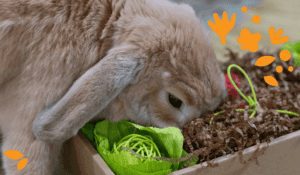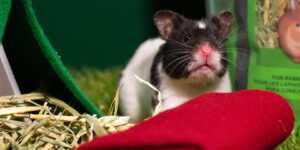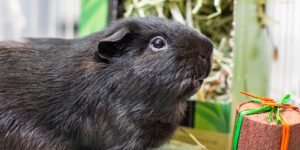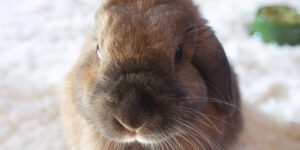Authors: Dr. Micah Kohles and Kellie Hayden
Updated: July 3, 2024
Whether nibbling on their favorite hay, munching on leafy greens, or chewing on their favorite toys, small pets are wired to chew all day, every day. As it turns out, chewing is an instinctual behavior in rabbits, guinea pigs, chinchillas, and other small pets. In this blog we discuss the important benefits chewing as a behavior provides to your small pet’s health and happiness, how to support small pet chewing instincts in healthy ways, and what kinds of enrichment can help meet this instinctual behavior’s needs.
How to Support Your Small Pet’s Instinctual Chewing Behaviors
We know that chewing instincts and small pets go hand-in-hand. Chewing is something they do all the time, all day long. There are some really important reasons as to why they engage in this behavior so often. Certainly we understand the need for them to chew their food, but chewing is also an important way for them to understand the world they live in.

What are the Benefits of Chewing for Small Pets?
The primary benefits of chewing include but are not limited to:
- Beneficial dental wear
- Mental and physical enrichment
- Boredom-based behavior prevention
- Strengthening the human/animal bond
Dental Health Benefits
Chewing is a critical part of maintaining your small pet’s dental health. Many small exotic mammal species have what are called open-rooted teeth. When an animal has open-rooted teeth, it means that their teeth constantly grow throughout their entire life. While rat, mice, hamster, and gerbil incisors are open-rooted, both the incisors and molars of chinchillas, guinea pigs, and rabbits are open-rooted to keep up with the continual wear caused by their high fiber diets.
In the wild, your pet would munch on grasses, branches, bark, and any number of other hard, fibrous materials. In captivity, pet parents must provide ample chewing materials to satisfy this instinctual behavior to help prevent dental disease.
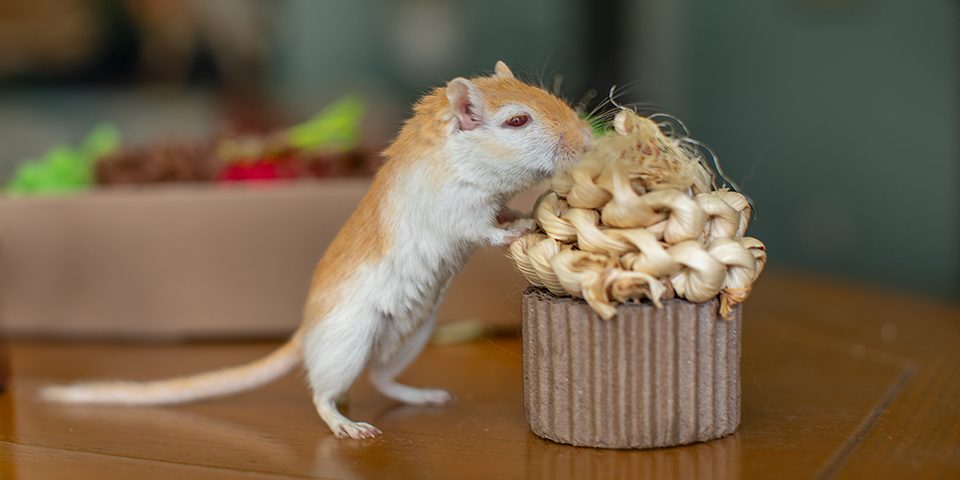
Mental and Physical Health Benefits
Chewing is a very mentally stimulating behavior for small pets. As they explore things in their environment and what things mean to them, chewing provides mental stimulation and a way for them to interact with their world.
Chewing also encourages physical movement and play, which can help limit your small pet’s chance of obesity. The more activity that pet parents can encourage, the more movement we can stimulate.
Boredom-based Behavior Prevention
Just like us, our pets can get bored of doing the same thing day after day. When animals are confined to living in small, unenriching habitats, boredom-based behaviors typically develop. These behaviors can include bar-chewing, barbering their fur, or directing aggressive behaviors towards cage mates or people. For this reason, it’s important to not only provide a large habitat, but to also accessorize that space with enriching natural chews that can help stimulate mental engagement and physical activity to help prevent these boredom-based behaviors.
Strengthening the Bond Between You and Your Pet
Last, but not least, providing enrichment in the habitat helps strengthen the bond you have with your pet. The more you interact with your pet when providing chew items or other forms of enrichment, the stronger that relationship will be!
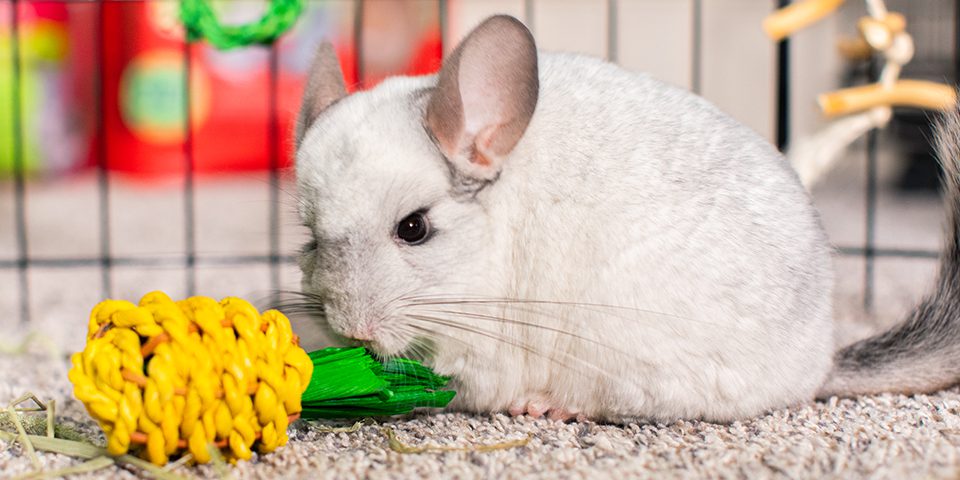
Chewing Checklist for Small Pets
High Fiber Hay All Day for Healthy Chewing
Satisfying your small herbivore’s chewing instinct should always start with hay. Every small herbivore should have unlimited access to fresh grass hay daily. Hay should be the primary source of fiber in your pet’s diet; in addition to providing essential dental wear, the fiber in hay is responsible for keeping your pet’s digestive system healthy and moving. Feeding a diversity of grass hays (such as our Hay Blends, Botanical Hay, and Organic Meadow Hay) can also lead to more interest, interaction, and chewing.
Safe Natural Chews
Hay is great, but providing additional chewing options will keep your pet mentally engaged. Willow, wicker, sisal, and jute are some ideal materials. Chews made entirely from hay like our Timothy Twists are great in that your pet can safely consume hay-based items. Even clean cardboard makes a fantastic, easily accessible chewing material that can be used to make DIY enrichment.
Any chewing material you provide to your little one should never be chemically treated. Place natural chews throughout the habitat and rotate them regularly by changing out old chews for new ones to keep things interesting for your pet. Oxbow offers a wide variety of safe, all-natural small pet chew toys that are specifically designed with the needs and preferences of small pets in mind.
Chewable Hideouts for Rest and Relaxation
Consider that hideouts like our Timothy Bungalow can also be a source of chewing material. Prey species are wired to hide away to escape stressors throughout the day, and all habitats should include at least one hiding space to support this hiding instinct. Chewable hideouts provide a space for small pets to relax in a place where they feel comfortable and safe. When small herbivores especially feel comfortable and safe, they’re going to naturally chew on the hay that surrounds them. If you’re looking for a chewable hideout specifically, always be sure to choose items with no wire, string, or other materials that could present choking hazards.
How to Promote Healthy Chewing in the Habitat
Before anything else, make sure that you’re providing your pet with as large of a habitat as possible.
Within a large habitat, provide ample amounts of appropriate chewing materials. Your small pet should have options on what chews they interact with. By providing a variety of toys and rotating which ones are available to your small pet, you can help keep things interesting within their habitat. Access to a variety of natural chews means there’s always a new sensory experience available for your pet, whether that’s new smells, sounds, or textures.
Safety should be a top priority when outfitting your pet’s habitat with enrichment. Watch how your little one engages with new enrichment before deciding if an item should remain in their habitat without supervision. If your pet seems unsure or scared of a new item, don’t force your pet to interact with it. Place the chew at a distance that allows them to interact with the item on their own terms, or remove it and try a different natural chew.
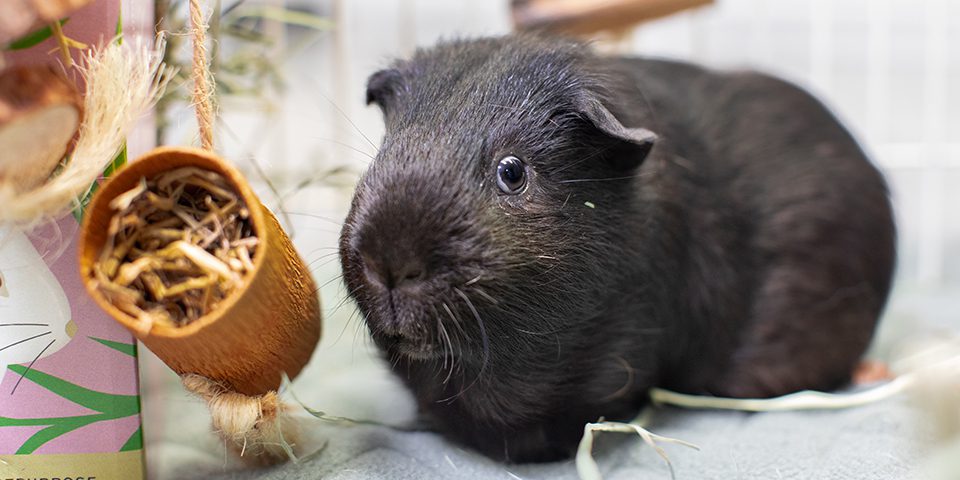
Chew-proofing Spaces in the Home for Pet Health and Safety
Oxbow strongly recommends that pet parents regularly give their small pet time outside of the habitat to play and explore. Simply put, however, anything that your small pet can access, they will likely chew. This can be the carpet on the floor, a leg of your couch, or the base boards of your room. If they can reach it, it’s safe to assume they may chew on it. Because of this, we need to be very thoughtful about pet-proofing any spaces where our little ones are likely to free-roam.
Before allowing your pet to free-roam, think about materials that might be harmful for your pet to chew on. Common household objects like electrical cords, anything made of plastic or metal, or house plants (many of which on the market today are toxic to ingest) are potential hazards. These materials are not in line with what their dentition is built for and can cause all kinds of health problems if they can be accessed to chew on.
In summary, chewing is vitally important for small pets in terms of dental health, mental stimulation, and physical enrichment. Fortunately, many safe and nutritionally appropriate chew options like our wide assortment of Enriched Life products exist now compared to even a decade ago. Your job as a pet parent is to think of creative ways to encourage your pet to chew on appropriate materials every day. When we tie this behavior to proper nutrition, we in turn set a strong foundation for the health and happiness of our pets.

